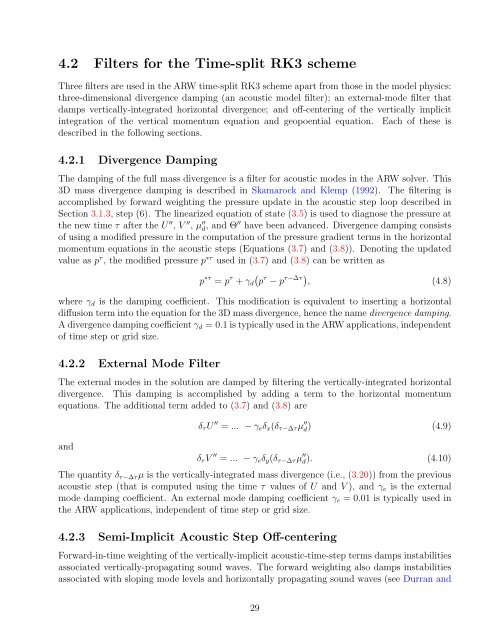Advanced Research WRF (ARW) Technical Note - MMM - University ...
Advanced Research WRF (ARW) Technical Note - MMM - University ...
Advanced Research WRF (ARW) Technical Note - MMM - University ...
Create successful ePaper yourself
Turn your PDF publications into a flip-book with our unique Google optimized e-Paper software.
4.2 Filters for the Time-split RK3 scheme<br />
Three filters are used in the <strong>ARW</strong> time-split RK3 scheme apart from those in the model physics:<br />
three-dimensional divergence damping (an acoustic model filter); an external-mode filter that<br />
damps vertically-integrated horizontal divergence; and off-centering of the vertically implicit<br />
integration of the vertical momentum equation and geopoential equation. Each of these is<br />
described in the following sections.<br />
4.2.1 Divergence Damping<br />
The damping of the full mass divergence is a filter for acoustic modes in the <strong>ARW</strong> solver. This<br />
3D mass divergence damping is described in Skamarock and Klemp (1992). The filtering is<br />
accomplished by forward weighting the pressure update in the acoustic step loop described in<br />
Section 3.1.3, step (6). The linearized equation of state (3.5) is used to diagnose the pressure at<br />
the new time τ after the U ′′ , V ′′ , µ ′′<br />
d , and Θ′′ have been advanced. Divergence damping consists<br />
of using a modified pressure in the computation of the pressure gradient terms in the horizontal<br />
momentum equations in the acoustic steps (Equations (3.7) and (3.8)). Denoting the updated<br />
value as p τ , the modified pressure p ∗τ used in (3.7) and (3.8) can be written as<br />
p ∗τ = p τ + γd<br />
p τ − p τ−∆τ , (4.8)<br />
where γd is the damping coefficient. This modification is equivalent to inserting a horizontal<br />
diffusion term into the equation for the 3D mass divergence, hence the name divergence damping.<br />
A divergence damping coefficient γd = 0.1 is typically used in the <strong>ARW</strong> applications, independent<br />
of time step or grid size.<br />
4.2.2 External Mode Filter<br />
The external modes in the solution are damped by filtering the vertically-integrated horizontal<br />
divergence. This damping is accomplished by adding a term to the horizontal momentum<br />
equations. The additional term added to (3.7) and (3.8) are<br />
and<br />
δτU ′′ = ... − γeδx(δτ−∆τµ ′′<br />
d) (4.9)<br />
δτV ′′ = ... − γeδy(δτ−∆τµ ′′<br />
d). (4.10)<br />
The quantity δτ−∆τµ is the vertically-integrated mass divergence (i.e., (3.20)) from the previous<br />
acoustic step (that is computed using the time τ values of U and V ), and γe is the external<br />
mode damping coefficient. An external mode damping coefficient γe = 0.01 is typically used in<br />
the <strong>ARW</strong> applications, independent of time step or grid size.<br />
4.2.3 Semi-Implicit Acoustic Step Off-centering<br />
Forward-in-time weighting of the vertically-implicit acoustic-time-step terms damps instabilities<br />
associated vertically-propagating sound waves. The forward weighting also damps instabilities<br />
associated with sloping mode levels and horizontally propagating sound waves (see Durran and<br />
29
















